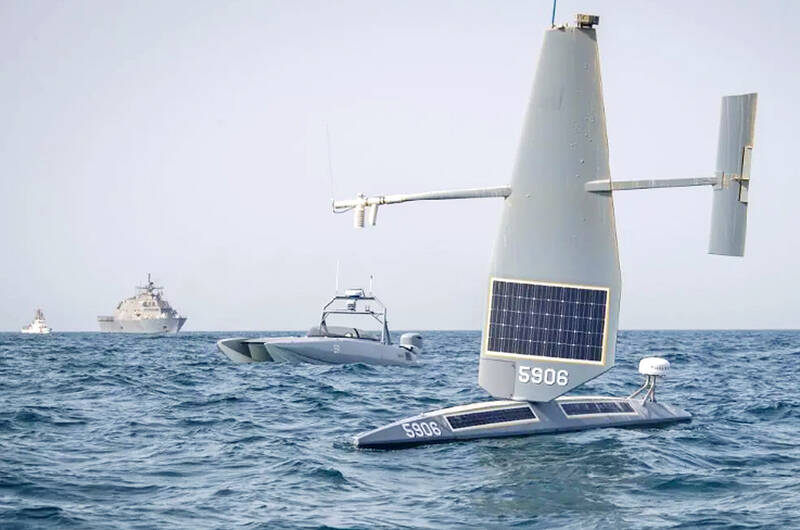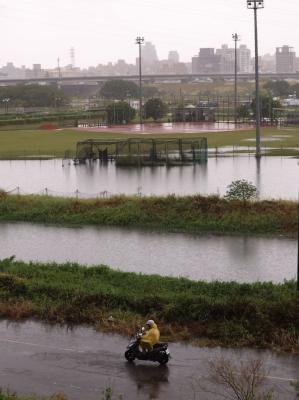A naval enthusiast Web site on Sunday analyzed the US Navy’s operation “Hellscape” and what the plan to launch thousands of drones around Taiwan to deter a Chinese invasion would entail.
The concept was reported by Washington Post columnist Josh Rogin in an article published on Monday last week in which he quoted US Indo-Pacific Commander Admiral Samuel Paparo said the strategy would involve deploying thousands of uncrewed submarines, surface vessels and aerial vehicles around Taiwan to buy the nation and its partners time to assemble a response.
Paparo told Rogin about the plan on the sidelines of the Shangri-La Dialogue defense forum in Singapore.

Photo: US Navy via AP
The Naval News report, “Breaking down the US navy’s ‘Hellscape’ in detail,” said that former US commander of the Indo-Pacific Command Admiral John Aquilino first coined the term in August last year at the Emerging Technologies for Defense Conference and Exhibition in Washington.
“‘Hellscape’ envisions a battlefield filled with tens of thousands of unmanned ships, aircraft and submarines all working in tandem to engage thousands of targets across the vast span of the West Pacific,” the report said.
US Deputy Secretary of Defense Kathleen Hicks announced the Replicator initiative at the same conference, and since then, “the program has been hard at work developing new capabilities,” it said.
Many of those capabilities would have “direct applications to the Hellscape concept,” it said.
“The vision of ‘Hellscape’ is clear in the [US] Department of Defense and dozens of active programs, some under the Replicator initiatives and others independent of it, are pushing towards the bigger picture of an Indo-Pacific full of unmanned systems in a hypothetical war,” it said.
The strategy would feature uncrewed systems in every domain, including “one-way attack drones like the AeroVironment Switchblade 600 or UVison Hero-120,” Naval News reported.
“The US Marine Corps are specifically focused on loitering munitions and one-way attack drones and have issued contracts in 2021 and 2024 for integration and procurement of various unmanned systems,” it said, adding that the US Marine Corps last year “unveiled a concept of Hero-120 loitering munitions installed on a Long-Range Unmanned Surface Vessel.”
“The second role of ‘Hellscape’ could be to gather intelligence and put infrastructure in place to support a GPS and intelligence denied environment,” the report said.
Connected by satellites, high-altitude long endurance uncrewed aerial vehicles and “other aspects of ‘Project Overmatch’ that network, drones would engage large amphibious fleets crossing the Taiwan Strait from multiple vectors, coming from islands, undersea and from drone motherships far outside the first island chain,” it said.

TRAFFIC SAFETY RULES: A positive result in a drug test would result in a two-year license suspension for the driver and vehicle, and a fine of up to NT$180,000 The Ministry of Transportation and Communications is to authorize police to conduct roadside saliva tests by the end of the year to deter people from driving while under the influence of narcotics, it said yesterday. The ministry last month unveiled a draft of amended regulations governing traffic safety rules and penalties, which included provisions empowering police to conduct mandatory saliva tests on drivers. While currently rules authorize police to use oral fluid testing kits for signs of drug use, they do not establish penalties for noncompliance or operating procedures for officers to follow, the ministry said. The proposed changes to the regulations require

Taipei, New Taipei City, Keelung and Taoyuan would issue a decision at 8pm on whether to cancel work and school tomorrow due to forecasted heavy rain, Keelung Mayor Hsieh Kuo-liang (謝國樑) said today. Hsieh told reporters that absent some pressing reason, the four northern cities would announce the decision jointly at 8pm. Keelung is expected to receive between 300mm and 490mm of rain in the period from 2pm today through 2pm tomorrow, Central Weather Administration data showed. Keelung City Government regulations stipulate that school and work can be canceled if rain totals in mountainous or low-elevation areas are forecast to exceed 350mm in

1.4nm WAFERS: While TSMC is gearing up to expand its overseas production, it would also continue to invest in Taiwan, company chairman and CEO C.C. Wei said Taiwan Semiconductor Manufacturing Co (TSMC) has applied for permission to construct a new plant in the Central Taiwan Science Park (中部科學園區), which it would use for the production of new high-speed wafers, the National Science and Technology Council said yesterday. The council, which supervises three major science parks in Taiwan, confirmed that the Central Taiwan Science Park Bureau had received an application on Friday from TSMC, the world’s largest contract chipmaker, to commence work on the new A14 fab. A14 technology, a 1.4 nanometer (nm) process, is designed to drive artificial intelligence transformation by enabling faster computing and greater power

China Airlines Ltd (CAL) yesterday morning joined SkyTeam’s Aviation Challenge for the fourth time, operating a demonstration flight for “net zero carbon emissions” from Taiwan Taoyuan International Airport to Bangkok. The flight used sustainable aviation fuel (SAF) at a ratio of up to 40 percent, the highest proportion CAL has achieved to date, the nation’s largest carrier said. Since April, SAF has become available to Taiwanese international carriers at Taipei International Airport (Songshan airport), Kaohsiung International Airport and Taoyuan airport. In previous challenges, CAL operated “net zero carbon emission flights” to Singapore and Japan. At a ceremony at Taoyuan airport, China Airlines chief sustainability